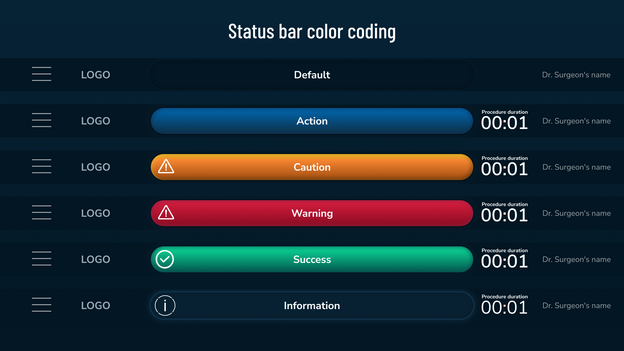Graphical User Interface Design for Surgical Brain Access Platform Device
- Andreas Baier
- Jan 10, 2023
- 3 min read
Updated: Feb 14, 2023
User Interface Design

Business Situation
Our client is an independent, non-profit, research and development organization focused on the development of technologies and interfacing mechanisms, that combine the latest in neuroscience, biology and engineering to create high-precision therapies that directly connect to complex brain circuits in a highly specific, safe and ethical way.
Our client develops a minimally invasive versatile surgical tool that integrates innovative imaging and sensing technology to provide unparalleled access, vision and navigation within the brain, which is essential to deliver therapeutics, to perform biopsies or to place intracranial electrodes.
Ergonomics Factory was tasked to develop the interaction concept and visual design of a surgical access device’s graphical user interface, and to develop an interactive mockup for assessing the system’s feasibility and usability with surgeons.
The Challenge
Define the user workflows and interaction concept of the graphical user interface that allows the surgeons to control the system during brain surgery.
Develop a visual design concept that meets the stakeholders’ expectations and regulatory requirements alike.
Create a flexible interaction system that integrates all required information and interactions within a clearly defined and simple logic that provides optimal support to surgeons during brain access.
Deliver a functional prototype of the graphical user interface that features the functionality of the program required for simulating the surgical procedure and testing the usability of the system.
The Solution
Ergonomics Factory applied the relevant standards and guidelines relating to medical device user interface design.
Definition and documentation of user requirements in the specific context of brain surgery.
Development of an interaction concept under systematic consideration of the intended use, intended use context, and intended users and their impact on the users’ interaction with the system.
Application of state-of-the-art safety requirements and ergonomic principles to ensure safe yet minimalistic design with a clear design language and appealing aesthetics.
Definition of a font and font size system based on the viewing distances of the different types of users during the procedure to ensure legibility under all expected use conditions.
Development of icons with concise text labels for all key-important functions.
Creation of illustrations to enhance user guidance through the surgical processes.
Consistent application of visual cues and contrasts to facilitate orientation and recognition of critical and non-critical system states.
Systematic application of Gestalt principles for the definition of screen layouts and illustrations.
“Their unique combination of user interface design expertise and human factors know-how was our primary reason to choose Ergonomics Factory as our partner. They brought excellent solutions to the table and made the complex appear simple without being simplistic. Ergonomics Factory delivered a design solution that was on time and budget with an end result that exceeded our expectations. I highly recommend Ergonomics Factory for any medical device design and development project requiring outstanding human factors engineering and user interface design expertise and an excellent schedule-to-budget performance.”
Matt, Engineering Manager
Outcomes
The graphical user interface includes all information and interactions required for performing the surgical procedure as per the system’s user requirements and intended use, and meets international standards and regulatory requirements for medical devices in the specific context of use of the device under development.
The client has an interactive prototype of the graphical user interface that allows the assessment of the systems feasibility and usability.
A graphical user interface that has been specifically defined and developed to support the client’s hardware, i.e., the display’s resolution, dpi, screen size, and multi-touch capabilities.
Sizes of buttons and fonts as well as the spacing between elements that have been specifically designed for minimizing use-related risks and optimizing ease of use under the intended use conditions, including use of sterile gloves and supporting multiple operators from different user groups that may interact with the system at a time.
Use of a clear and concise color-coding system to facilitate distinction between different critical and non-critical system states and screen elements.
A consistent button-states system to ensure understanding of actions that are allowed, ongoing, or disabled during surgical procedure.
Prototype with functionality to simulate the surgical operation to allow for an accurate representation of the innovative surgical tool for feasibility and usability testing, including the speed and duration of the actions performed.
Benefits
Confidence in regulatory compliance related to user interface design for medical devices.
Unique and aesthetic user interface design that meets and exceeds the users’ expectations and supports the commercial success of the surgical system.
Interactive prototype that allows the assessment of the system’s feasibility and usability in human factors and use-related risks studies early during development.
Optimized project timelines and resources through the possibility of testing the interactive system early-on and without investing in resource-intensive development activities.
Support of interactive product presentations in which potential users and clients have the possibility to explore the system and its functionalities.
Updates
The client works with Ergonomics Factory on various projects in which we develop hard- and software user interface design concepts, create testable mockups, perform the required human factors engineering and user testing activities, use-related risk management activities, deliver the respective documentation, and provide regulatory support.













